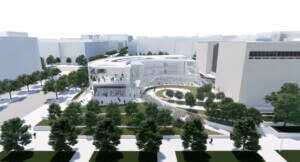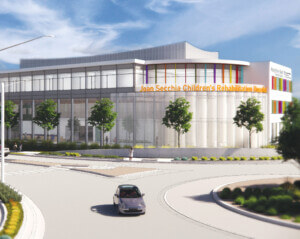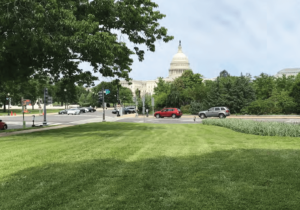The following is a Q&A between the Architect’s Newspaper and SmithGroup design team leaders Dayton Schroeter (DS), and Julian Arrington (JA) about the Society’s Cage installation on the National Mall, how it came about, what its impact has been, and what its future might be. After our initial preview of the pavilion ran, SmithGroup announced that Society’s Cage would remain open to the public for an additional week and will now close on September 12.
The interview below has been condensed for clarity.
AN: How and when did this come about? Who thought of it?
Dayton Schroeter: This was a grassroots effort amongst some colleagues within SmithGroup who got together in the aftermath of the George Floyd murder and wanted to really do something to sort of contextualize the murders historically and also contribute to the discussions that have been happening in our society and even without our profession as we all sort of reckon with the legacy of white supremacy and racism. And also just to start to dispel the myth of the sort of bad apple, the bad apple cop myth, and this idea that these murders are sort of anomalies.
We really wanted to do a deep dive and basically do a factual interpretation of the history of state violence in America, so that we could provide a pavilion that, in a sense, transcends opinion. Maybe I’m getting too deep into it., maybe I’m getting ahead of myself. But it basically started amongst a group of us. We really wanted to just contextualize these murders within the 400-year history of state violence in the colonized Americas. That’s really the genesis.
All in 15-by-15 feet?
DS: Exactly.
When you say contextualize, what do you mean?
DS: Maybe I can explain more. This was a process-driven design where the resulting aesthetic was really driven by data, and the data was driven by questions. We got together and really started to ask ourselves questions. The first question we asked is: What is the value of Black life? And you’ll actually see that on the pavilion.
Then we started to think more about the structures that impact Black life. What are those structures that impact Black life? What are the patterns? What are the racial and gender discrepancies inherent in those patterns? What is the relationship of Black people to the power structure?
As we asked those questions, we began to acquire data, and that data essentially began to inform the shape of the structure. The form and shape of the pavilion is literally a physical representation of racist institutional structures that have acted historically to compromise true equity and fairness in our society. The parti is basically an imperfect cube, which we see as a symbol of undue justice and harm in our society. The void in that cube we saw as a sort of symbolic representation of the systemic forces that devalue and compromise Black lives.
The facades themselves, they wear the bar graphs with statistical data that basically describes how African Americans have been impacted by these institutional structures of state violence, be it lynching, mass incarceration, capital punishment, and civilian deaths by police.
Those are the four themes. Because, in our research, basically what we began to uncover is that this sort of culture of state violence is a continuum. It’s a historic continuum that has manifested from the very inception of this country. It has changed form throughout the country’s history, but the end result is the same.
This is not a whimsical French folly in the landscape
DS: No. We say that the resulting architectural and sculptural form is social and political in nature because the questions that we asked are social and political in nature. That is what it is.
It’s taking something very ugly and rendering it in a beautiful way. Racism is an ugly thing. It’s an ugly phenomenon. What we tried to do, to the best of our abilities, is put it in a form that can sort of help communicate that ugliness, if you will, in a way that people can kind of appreciate it and see it for what it is.
Who was your client?
We were our client. This started out as a grassroots effort amongst like-minded individuals within the SmithGroup who came together and decided that we wanted to do something in the aftermath of these killings. We were going to essentially go to Home Depot and source the material on our own. At the time, we were thinking it was just going to be PVC pipe. We were going to get it painted. We were going to essentially reach out to our D.C. office to maybe get some financial support in addition to some local businesses that we have connections with.
It’s been about six weeks or so since we actually started, plus the week that it’s been installed. It’s been a pretty short-term process. And within the span of time that we were developing it, the corporate board got wind of it and they decided to support it and became our biggest donor. So the firm essentially provided the seed money, if you will, for us to make this possible, to actually get it professionally fabricated.
[SmithGroup] also provided tons of material and support to magnify our voices and get the word out, et cetera. For example, [corporate communications specialist] Christa [Montgomery] wasn’t involved initially. Christa came on board when we got the blessing of the corporate board. That was part of the resources that we were able to take advantage of, Christa’s expertise in public relations and being to get this thing out to the media and such. We didn’t have that type of reach before getting support from the SmithGroup.
Did you have a site in mind?
DS: When we did it, there was no site. It wasn’t designed with a specific site in mind. It was non-site specific It was thought to be a mobile installation that could travel anywhere, be located anywhere. That’s how we approached it.
How did you end up on the Mall, near the intersection of 12th and Madison N. W.?
DS: The opportunity to get this beautiful site, as amazing as it is, was happenstance, for the most part. We reached out to the city, the D.C. mayor’s office, they were super supportive. They loved the concept. But their hands were tied with regards to helping to get this on public space because D. C. as you know is still in Stage Two of the quarantine, and they’re not able to administer any public permits at this point. But the mayor’s office was actually the entity that recommended that we reach out to the National Park Service because the Park Service wasn’t beholden to the same restrictions.
Our ideal site at the time was Black Lives Matter Plaza [a two-block stretch of 16th Street N.W., near the White House], if you will because we were just assuming that that would be a natural place where this would be successful because of the audience that would be there.
But I think what I realized is that that may have been just preaching to the choir and the actual site that we got In some ways is much more powerful. It’s powerful because it’s surrounded by these powerful symbols of democracy, the [Washington] Monument, law and order with the Capitol building. And it just so happens that the Trump [International] hotel was just north of our site, so it’s like the symbol of crony capitalism and corruption as well.
So it was these beautiful contextual symbolic relationships that we were able to get, and then it just put us on neutral ground. There were so many people who just stumbled on the site, just didn’t even know about it, just happened to be strolling down the Mall and stumbled on it. That provided a great opportunity to reach people that we probably would not have been able to reach had it been on Black Lives Matter Plaza.
How close is this to the National Museum of African American History and Culture?
DS: It’s literally a block and a half away.
I thought you might have said you were an annex to the museum.
DS: I wish they had taken us on. I have been saying throughout this process, and especially when we secured this site, that I think of this as an outdoor museum. We were able to kind of provide content that supplemented the Smithsonian during the COVID quarantine lockdown in the midst of a pandemic, which is beautiful. And I think it’s incredibly important, with the timing of institutions like the National Museum of African American History and Culture being shut down, that we, in essence, were able to provide a sort of mini-museum, an abridged museum, in their absence. But they in no way were part of what we did. It just so happened to kind of work out.
Why did you go with this site?
DS: Honestly, when this site was mentioned, I just tuned all the other sites out immediately. I didn’t even really ponder over them at all. I just thought this was a no brainer.
We encourage one visitor at a time. Or a couple or a family, if they’re together. We really see the interior experience as a sort of sacred space, like a sanctum if you will, where the user is allowed to have personal space to reflect and contemplate everything that they are processing in that moment.
Does Society’s Cage close at night? Are there visiting hours?
It does not lock. We have docents on site 24 hours a day for the duration of this exhibit. It’s actually required as part of our agreement in the application, to man the installation.
It’s a different experience, seeing it at night versus seeing it in the day.
DS: It inverts. During the day, you see it more as an object. At night, I think you see it more as a space. The light feature is designed to have a sort of constellation effect, like stars. Depending on your place of interpretation, it can be interpreted in a lot of different ways. It can be very soothing for some, and calm and meditative, but very disturbing and eerie for others. That’s sort of the point. Good art allows for that range of interpretation, where people from all walks of life and experiences can really come and see it in their own different way, through their own lens.
Would you have done anything differently?
DS: Given the constraints that we had, I think it’s perfect. I think we rose to the challenge with the limited means that we had and did something powerful. If I had a little bit more time and we had a little bit more financial prowess, I would revisit the graphics. I would try to make the graphics a little bit more integrated, not an applied thing, not an applique.
What was the budget?
DS: There was no real set budget. We wanted to make sure that whatever we did was ethically and principally reasonable, and we wanted to make sure in our fundraising that there was ample opportunity to provide a means for direct action. By direct action, I mean that we have, as part of our fundraising efforts, we’re raising money for scholarships through the Architects Foundation, for disadvantaged kids. We wanted to make sure that there was an opportunity here to have that kind of direct action. There’s two parts to the pavilion, education and building empathy. It’s also providing those scholarship opportunities for those disadvantaged youths.
Have you determined where else it might travel after the Mall?
DS: We haven’t made a decision. There have been inquiries from as far away as San Francisco and plenty of local requests, but we have not committed to a final site. That is something that we’ll have to deliberate and make a quick decision on in the next coming days.
Where else could Society’s Cage go in Washington?
DS: We have eight wards. There’s plenty of opportunity here in the District. It’s had an incredible effect. I don’t want to assume that the National Mall is sort of the stand-in representation for this region. I think there’s ample opportunity throughout the city to locate this in public spaces that can have a tremendous impact on people—everyday people, black people, white people, old, young, Latin. Asian, progressives, conservatives. I think there’s just a tremendous amount of opportunity here.
We also have an AR feature that you can find on our website. It allows anyone to virtually occupy the pavilion through Augmented Reality. Regardless of where you are, you can get onto our website using your phone. You’ll be able to essentially insert the model virtually into any physical space that can house it, if it’s a 15-foot-by-15-foot-by-15-foot cube, and experience it virtually. We also have that option.
Could you have more than one of these and expand its reach that way? Build three of them to travel?
DS: Yes. To take it one step further, one of the aspirational goals conceptionally was to build other versions of this cube. In many respects, this is a cube that describes the Black experience in America. But there could be inherent value in a white version, an Asian version, a Latino version, and to see them side by side, occupying the same space where people might be able to experience them one at a time. People might be able to compare them. And just thinking about the sort of spatial dynamics of how these cubes might differ, or how they might even be expressed differently through materiality and the different types of information and text that you would get, it could be an amazing artistic next step.
How long is the average visit?
DS: There have been people who won’t go home. You go to this site, some people are crying. They’re running up to us to thank us for this work. It just varies, depending on the individual person. Some people have come back, or they bring a friend to see it. The daytime experience and nighttime experience are very different. It’s almost essential for any individual to come back and see it in those two states.
Do you wish that Donald Trump would see the installation?
Julian Arrington: The idea is that it’s open to anybody to visit. We would love to have him here if he comes with an open mind. The idea is that you’re positioning people with the opportunity to be empathic, to really take the time to absorb information and allow them to have an effective interaction with the pavilion.
DS: There are a lot of redemptive opportunities here. This to me reveals the power of truth-telling. It’s a testament to the universal power of truth. I think it’s going to be a reckoning for some and a moment of pause and reflection for others. I don’t know that Trump, given his narcissism, would be able to appreciate it, but certainly, there are probably others in his administration who might be a little bit more amenable and find opportunities in here for true reflection and contemplation.
It’s not an opinion. It’s not Julian’s opinion and my opinion. This is a fact-based installation that’s based on statistical data that we’ve accumulated in order to contextualize the murders of George Floyd and Breonna Taylor. So that we can begin to see these murders with a wider contextual lens, a wider spectrum, and not see these murders as anomalies but rather as part of a continuum that’s existed in this country since the very beginning. So hopefully, if someone who’s in a position of power can come here and can connect the dots and begin to see how they may be culpable in helping to promote this institution of anti-Black state violence, I think there’s redemptive power there.
What are some powerful reactions you have seen?
JA: We have photos of a mother [telling] her son about it, and her son sort of refused, saying he really didn’t really want to go in the cage. We have a few people break out in tears. Some people have brought roses.
Have people left things at the site?
JA: We started to leave roses as a tribute to the ancestors, the sanctum aspect. And I think people took a cue. One woman brought roses. She was very touched.
DS: My most impactful moment was when a gentleman, an older white gentleman, approached me, literally in tears, almost in a confessional tone. He was confiding in me about his complicity in encouraging and enabling racism in his lifetime. He said he was ashamed. He wanted to do better.
Did the man know you were involved in the design?
DS He did. He asked me if I was one of the designers, the artists, I think he called it. I told him I was. And so then he began to share with me more of his history, his past. I didn’t really expect that level of honesty or for it to have that level of impact.
Forget about how I feel or how we feel. There’s always this tendency to create these wonderful Kumbaya moments where people can kind of come together and meet one another, and you think by having these dialogues, people will come to an understanding. There have been 400 years of master-slave relationships where the master was intimately involved with some of his slaves and obviously that dynamic of intimacy had no fundamental impact on the dynamics of power, right? So, creating change, creating societal evolution, is not going to come about by surface-level Kumbaya moments. You have to dig deep. You have to tell the truth. People have to look in the mirror. People have to be honest with themselves. That’s the only way to move forward.











